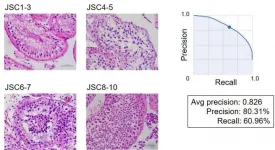(Press-News.org) DALLAS, May 10, 2021-- Hospitalized COVID-19 patients with impaired first-phase ejection fraction were nearly 5 times more likely to die compared to patients with healthier measures of this early, often undetected sign of heart failure, according to new research published today in Hypertension, an American Heart Association journal. First-phase ejection fraction is a measure of the left ventricular ejection fraction until the time of maximal ventricular contraction.
Cardiovascular risk factors and/or disease have been recognized as COVID-19 risk factors that have a high negative impact on patient outcomes, since early in the SARS-CoV-2 pandemic. Researchers hypothesized that predisposition to heart failure would be associated with more severe cases of COVID-19 in hospitalized patients.
"Traditionally, heart function is measured by ejection fraction, or how much blood the left ventricle pumps out with each contraction of the heart," said study author Phil Chowienczyk, M.B.B.S., B.Sc., professor of cardiovascular clinical pharmacology at St. Thomas' Hospital, in London. "First-phase ejection fraction is a new measure of the heart's function that seems to be much more sensitive of early, undetected damage to the heart than traditional ejection fraction measures."
To determine if first-phase ejection fraction predicted adverse patient outcomes, researchers analyzed mortality rates for 129 hospitalized COVID-19 patients in Wuhan, China, and 251 hospitalized COVID-19 patients in South London, treated between February and May 2020, were analyzed. All patients had echocardiography upon hospital admission, and the average patient age was 58 years. Researchers compared echocardiography results of COVID-19 patients to adult patients with otherwise similar health profiles who had an echocardiography test before the pandemic.
First-phase ejection fraction was measured with conventional echocardiography imaging conducted at hospitalized patients' bedsides. Researchers note that there is not a universally established 'normal' value for first-phase ejection fraction. Based on previous research, they estimated that the normal first-phase ejection fraction value should be above 25%. When first-phase ejection fraction was less than 25%, researchers referred to it as 'impaired,' suggesting relatively subtle signs of heart damage.
The authors found that COVID-19 patients with a first-phase ejection fraction of less than 25% had a nearly five-fold higher risk of death than those with an ejection fraction of 25% or higher. They also found that a similar proportion of people with similar risk factors who did not have COVID-19 had low values of first-phase ejection fraction. This suggests that the damage to the heart may be due to chronic pre-existing conditions and was not the result of COVID-19 infection.
"Patients with impaired first-phase ejection fraction could be prioritized for vaccines and, if they get COVID-19, monitored closely at the early stages of their illness to prevent deterioration," Chowienczyk said. "The findings suggest that if we can prevent the very early chronic damage to the heart detected using first-phase ejection fraction imaging, then people will be much more likely to survive respiratory infections like COVID-19. Healthy lifestyle choices, better treatments and adherence to treatments for high blood pressure and high cholesterol are also important."
Researchers note that this is a relatively small study, so the findings need to be confirmed in larger studies with more patients. If the results are confirmed, first-phase ejection fraction could be a new way to identify patients at elevated risk of dying from COVID-19 and possibly other types of pneumonia.
INFORMATION:
Co-authors are Haotian Gu, Ph.D.; Chiara Cirillo, M.D.; Adam A. Nabeebaccus, M.B.Ch.B., Ph.D.; Zhenxing Sun, M.D.; Lingyun Fang, M.D., Ph.D.; Yuji Xie, M.D.; Ozan Demir, M.B.B.S., M.Sc.; Nishita Desai, M.B.B.S.; Lin He, M.D., Ph.D.; Qing Lü, M.D., Ph.D.; Eleni Nakou, M.D., Ph.D.; Kevin O'Gallagher, M.B.B.S.; Christos Tountas, M.D., Ph.D.; Apostolia Marvaki, M.D., Ph.D.; Mark Monaghan, M.Sc., Ph.D.; Divaka Perera, M.D.; Ana Pericao, M.D.; Matthew Ryan, M.B.Ch.B.; Hannah Sinclair, B.M.; Vasileios Stylianidis, M.D., M.Sc.; Kelly Victor, M.Sc.; Bin Wang, M.D., Ph.D.; Jing Wang, M.D., Ph.D.; Rui Wang, M.D.; Chun Wu, M.D., Ph.D.; Yali Yang, M.D., Ph.D.; Hongliang Yuan, M.D.; Danqing Zhang, M.D.; Yongxing Zhang, M.D.; Luca Faconti, Ph.D.; Alexandros Papachristidis, M.D.; Li Zhang, M.D., Ph.D.; Gerald Carr-White, Ph.D.; Ajay M. Shah, M.D.; and Mingxing Xie, M.D., Ph.D.
The National Natural Science Foundation of China, the National Institute for Health Research and the British Heart Foundation funded this study.
Additional Resources:
Available multimedia is on right column of release link - https://newsroom.heart.org/news/undetected-early-heart-damage-raises-risk-of-death-in-hospitalized-covid-19-patients?preview=c3ea69d7a6fb6bff1d4c262986931b54
After May 10, view the manuscript online.
COVID-19: Tsunami of chronic health conditions expected, research & health care disrupted
Heart disease and stroke medical experts urge public to get COVID-19 vaccinations
Follow AHA/ASA news on Twitter @HeartNews
Follow news from the AHA's Hypertension journal @HyperAHA
Statements and conclusions of studies published in the American Heart Association's scientific journals are solely those of the study authors and do not necessarily reflect the Association's policy or position. The Association makes no representation or guarantee as to their accuracy or reliability. The Association receives funding primarily from individuals; foundations and corporations (including pharmaceutical, device manufacturers and other companies) also make donations and fund specific Association programs and events. The Association has strict policies to prevent these relationships from influencing the science content. Revenues from pharmaceutical and biotech companies, device manufacturers and health insurance providers are available here, and the Association's overall financial information is available here.
About the American Heart Association
The American Heart Association is a relentless force for a world of longer, healthier lives. We are dedicated to ensuring equitable health in all communities. Through collaboration with numerous organizations, and powered by millions of volunteers, we fund innovative research, advocate for the public's health and share lifesaving resources. The Dallas-based organization has been a leading source of health information for nearly a century. Connect with us on heart.org, Facebook, Twitter or by calling 1-800-AHA-USA1.
DALLAS, May 10, 2021 — Managing weight, blood pressure and cholesterol in children may help protect brain function in later life, according to new research published today in the American Heart Association’s flagship journal Circulation. This is the first study to highlight that cardiovascular risk factors accumulated from childhood through mid-life may influence poor cognitive performance at midlife.
Previous research has indicated that nearly 1 in 5 people older than 60 have at least mild loss of brain function. Cognitive deficits are known to be linked with cardiovascular risk factors, ...
DALLAS, May 10, 2021 — In a small study, researchers found college athletes who contracted COVID-19 rarely had cardiac complications. Most had mild COVID symptoms that did not require treatment, and in a small percentage of those with abnormal cardiac testing, there was no evidence of heart damage on special imaging tests. All athletes returned to sports without any health concerns, according to new research published today in the American Heart Association’s flagship journal Circulation.
In spring 2020, concerns about heart damage, especially inflammation, among athletes with COVID-19 led to recommendations for cardiac screening based on symptom severity before resuming training and competition. The preferred diagnostic test for heart inflammation is an MRI of the heart, ...
Low levels of serotonin in the brain are seen as a possible cause of depression and many antidepressants act by blocking a protein that transports serotonin away from the nerve cells. A brain imaging study at Karolinska Institutet now shows that the average level of the serotonin transporter increased in a group of 17 individuals who recovered from depression after cognitive behavioural therapy. The results are published in the journal Translational Psychiatry.
"Our results suggest that changes to the serotonin system are part of the biology of depression and that this change is related to the episode rather than a static feature - a state rather than a trait," says the study's last author Johan Lundberg, researcher at the Department of Clinical Neuroscience, ...
What has fluid physics to do with the spreading of the Corona virus? Whirlpools and pandemics seem to be rather different things, certainly in terms of comfort. Yet, newest findings about epidemic spreading come from Physics professor Björn Hof and his research group at the Institute of Science and Technology Austria (IST Austria), who specialize in fluids and turbulent flows. When early last year Björn Hof had to cancel his scheduled visit to Wuhan, his wife's hometown, his focus abruptly shifted to epidemic spreading.
"My group normally investigates turbulent flows in pipes and channels", he explains, "Over the last 10 years we have shown that the onset of turbulence is described ...
Infertility affects females and males equally. In male infertility, azoospermia (a medical condition with no sperm in semen) is a major problem that prevents a couple from having a child. For the treatment of patients with azoospermia, testicular sperm extraction (TESE) is required to obtain mature sperms. When examined, histological specimens are typically given a score, called the Johnsen score, on a scale of 1 to 10, based on the histopathological features of the testis.
"The Johnsen score has been widely used in urology since it was first reported 50 ...
Researchers at Linköping University, Sweden, have made several discoveries on the functioning mechanisms of the inner hair cells of the ear, which convert sounds into nerve signals that are processed in the brain. The results, presented in the scientific journal Nature Communications, challenge the current picture of the anatomical organisation and workings of the hearing organ, which has prevailed for decades. A deeper understanding of how the hair cells are stimulated by sound is important for such matters as the optimisation of hearing aids and cochlear implants for people with hearing loss.
In ...
In 1884, Edwin Abbott wrote the novel Flatland: A Romance in Many Dimensions as a satire of Victorian hierarchy. He imagined a world that existed only in two dimensions, where the beings are 2D geometric figures. The physics of such a world is somewhat akin to that of modern 2D materials, such as graphene and transition metal dichalcogenides, which include tungsten disulfide (WS2), tungsten diselenide (WSe2), molybdenum disulfide (MoS2) and molybdenum diselenide (MoSe2).
Modern 2D materials consist of single-atom layers, where electrons can move ...
UK landowners and conservationists welcome wider-spread use of Gene Conservation Units (GCUs) to help protect some of the rarest plants and insects, research at the University of York has shown.
In particular the Great Yellow Bumblebee and the Mountain Ringlet Butterfly, which are at risk of further population decline, would benefit from Gene Conservation Units, currently only employed for forest trees and agricultural species or their relatives.
Genetic diversity in these species is essential if they are to adapt to new, and often challenging, environmental conditions. Gene Conservation Units are areas of land managed to allow the recovery of species, and maintain evolutionary processes to enable them to adapt to environmental change.
For tree species, ...
FRANKFURT. When the SARS-CoV-2 virus mutates, this initially only means that there is a change in its genetic blueprint. The mutation may lead, for example, to an amino acid being exchanged at a particular site in a viral protein. In order to quickly assess the effect of this change, a three-dimensional image of the viral protein is extremely helpful. This is because it shows whether the switch in amino acid has consequences for the function of the protein - or for the interaction with a potential drug or antibody.
Researchers at Goethe University Frankfurt and TU Darmstadt began networking internationally from the very start of the pandemic. Their goal: to describe the three-dimensional structures ...
Thousands of sharks have been illegally caught in a Marine Protected Area (MPA) in the Indian Ocean, new research shows.
The MPA was created in 2010 around the Chagos Archipelago, also known as the British Indian Ocean Territory (BIOT), banning all fishing there.
The new study examined information on illegal fishing in the MPA - a vast (640,000 km²/250,000 mi2) area containing pristine and remote reefs.
Enforcement data suggests more than 14,000 sharks were caught in the MPA from 2010-20, but discussions with fishers in the region suggest the true number was "considerably ...







